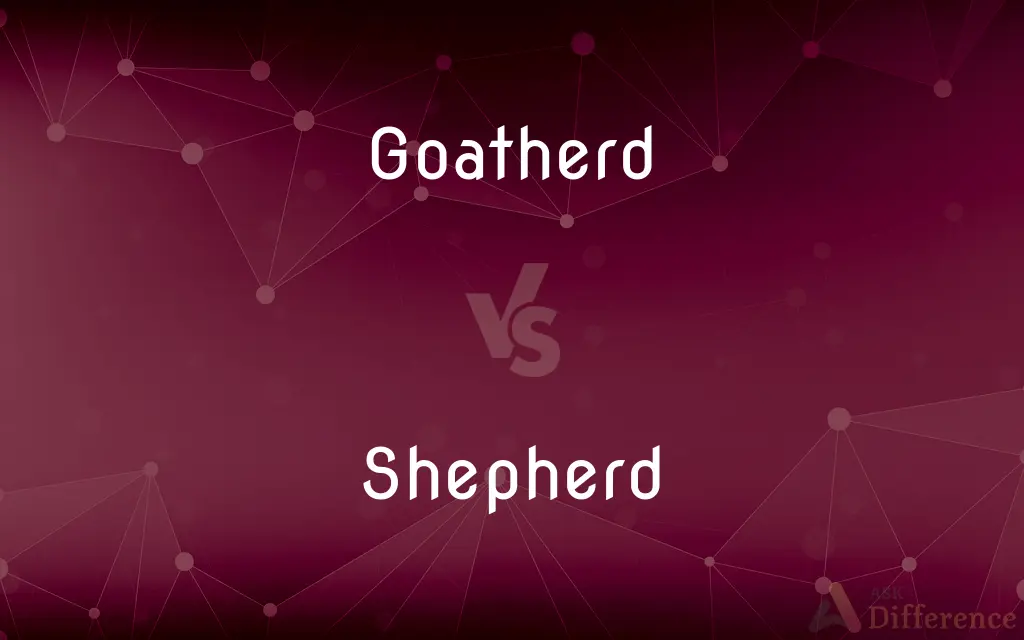Goatherd vs. Shepherd — What's the Difference?
By Fiza Rafique & Urooj Arif — Updated on May 13, 2024
A goatherd specializes in raising and managing goats, focusing on their feeding and breeding, while a shepherd cares specifically for sheep, guiding their grazing and protecting them.

Difference Between Goatherd and Shepherd
Table of Contents
ADVERTISEMENT
Key Differences
Goatherds are dedicated to the care and management of goats, ensuring their well-being and productivity in terms of milk, meat, and fiber, whereas shepherds are responsible for the nurturing, protection, and herding of sheep, focusing on wool, meat, and sometimes milk.
Goatherds often deal with the agile and curious nature of goats, which can involve managing animals in rugged terrain and ensuring they do not escape or cause damage, on the other hand, shepherds manage herds often characterized by their flocking behavior, requiring vigilance against predators and careful grazing management.
The techniques and tools used by goatherds may differ, given goats' ability to climb and browse higher vegetation, whereas shepherds typically use dogs and staffs to guide sheep which primarily graze on grass.
Goatherding typically requires knowledge of specific goat breeds and their care, including health issues unique to goats, such as their susceptibility to certain parasites, while shepherding involves an understanding of sheep breeds, wool management, and common ovine diseases.
In cultural contexts, goatherds and shepherds often appear distinctly in folklore and history, reflecting their specific roles and environments; goatherds are often portrayed as rugged individualists, while shepherds are frequently depicted as peaceful, pastoral figures.
ADVERTISEMENT
Comparison Chart
Animals Managed
Goats
Sheep
Primary Concern
Milk, meat, fiber
Wool, meat, milk
Environment
Often rugged, varied terrain
Typically pastoral, open fields
Tools and Methods
May include high fences, climbing surfaces
Often involve dogs, staffs for herding
Common Representations
Independent, adaptable individuals
Peaceful, pastoral figures
Compare with Definitions
Goatherd
A person who manages, breeds, and cares for goats.
The goatherd moved the goats to a new pasture to browse.
Shepherd
Uses dogs and staffs to manage and protect the sheep.
The shepherd’s trained dogs skillfully rounded up the sheep.
Goatherd
Typically works in varied terrains, adapting to goats' climbing abilities.
The goatherd built a fence sturdy enough to contain the adventurous goats.
Shepherd
Monitors sheep for diseases and oversees their breeding.
The shepherd vaccinated his flock against common sheep illnesses.
Goatherd
Often seen as rugged and self-sufficient in cultural depictions.
Local tales often celebrate the goatherd’s knowledge of the mountains.
Shepherd
Often depicted as peaceful, guiding figures in literature and art.
In many stories, the shepherd symbolizes tranquility and guidance.
Goatherd
Focuses on the production of goat milk, cheese, and meat.
The goatherd milks her goats twice a day for cheese production.
Shepherd
A person who cares for sheep, ensuring their safety and health.
The shepherd led his flock to a grassy field at dawn.
Goatherd
Deals with the health and breeding of goats.
The goatherd treated the goats for parasites prevalent in their breed.
Shepherd
Concerned primarily with wool, meat, and sometimes milk production.
The shepherd shears his sheep every spring to collect wool.
Goatherd
A goatherd or goatherder is a person who herds goats as a vocational activity. It is similar to a shepherd who herds sheep.
Shepherd
A shepherd or sheepherder is a person who tends, herds, feeds, or guards herds of sheep. Shepherd derives from Old English sceaphierde (sceap 'sheep' + hierde 'herder').
Goatherd
A person who herds, tends goats.
Shepherd
A person who tends and rears sheep.
Goatherd
One who tends goats.
Shepherd
Tend (sheep) as a shepherd.
Goatherd
A person who tends a flock of goats
Shepherd
Guide or direct in a particular direction
I shepherded them through the door
Shepherd
One who herds, guards, and tends sheep.
Shepherd
One who cares for and guides a group of people, as a minister or teacher.
Shepherd
A German shepherd.
Shepherd
To herd or tend as a shepherd.
Shepherd
To guide or lead on a course
The counselors shepherded the campers toward the waterfront.
Shepherd
To direct or instruct in a certain manner
Shepherded the student through algebra.
Shepherd
A person who tends sheep, especially a grazing flock.
Shepherdess (f.)
Shepherd
A male sheep tender
Shepherdess (f.)
Shepherd
(figurative) Someone who watches over, looks after, or guides somebody.
Shepherdess (f.)
Shepherd
A male watcher/guardian/guider/leader
Shepherdess (f.)
Shepherd
(figurative) The pastor of a church; one who guides others in religion.
Shepherdess (f.)
Shepherd
A male pastor
Shepherdess (f.)
Shepherd
(poetic) A swain; a rustic male lover.
Shepherd
A German Shepherd.
Shepherd
(transitive) To watch over; to guide.
Shepherd
To obstruct an opponent from getting to the ball, either when a teammate has it or is going for it, or if the ball is about to bounce through the goal or out of bounds.
Shepherd
A man employed in tending, feeding, and guarding sheep, esp. a flock grazing at large.
Shepherd
The pastor of a church; one with the religious guidance of others.
Shepherd
To tend as a shepherd; to guard, herd, lead, or drive, as a shepherd.
White, fleecy clouds . . .
Shepherded by the slow, unwilling wind.
Shepherd
A clergyman who watches over a group of people
Shepherd
A herder of sheep (on an open range); someone who keeps the sheep together in a flock
Shepherd
Watch over like a shepherd, as a teacher of her pupils
Shepherd
Tend as a shepherd, as of sheep or goats
Common Curiosities
What are the economic benefits of shepherding?
Shepherding can be economically beneficial through the sale of wool, meat, and dairy products.
What skills are necessary to be a goatherd?
Skills include knowledge of goat behavior, dietary management, and healthcare practices specific to goats.
How does the terrain affect a goatherd’s work?
Goats' ability to navigate steep and varied terrain requires goatherds to manage more complex landscapes.
How do cultural perceptions of goatherds and shepherds differ?
Cultural perceptions vary, with goatherds often seen as more rugged and solitary, and shepherds viewed as more peaceful and nurturing.
Can a shepherd and a goatherd use the same methods?
While there may be overlaps in animal husbandry techniques, specific methods often differ due to the distinct nature of goats and sheep.
Do goatherds use working animals like shepherds do?
Goatherds may use dogs or other animals to help control and protect goats, though the type and training might differ from those used by shepherds.
Is goatherding more difficult than shepherding?
The difficulty can vary based on the environment, the behavior of the goats versus sheep, and the specific management practices required.
What historical significance do goatherds have?
Goatherds have been important in many cultures for their role in providing milk, meat, and fiber, especially in mountainous regions.
How do shepherds contribute to agricultural practices?
Shepherds play a crucial role in managing the land through controlled grazing, which can help sustain healthy grasslands.
Can goatherding and shepherding be sustainable practices?
Both can be sustainable with proper management techniques that consider environmental and animal welfare.
Why might someone choose to become a goatherd?
Individuals might choose goatherding for the lifestyle it offers, particularly those who prefer working in diverse and challenging outdoor settings.
What are common challenges faced by shepherds?
Challenges include predator management, disease control, and maintaining sustainable grazing.
How do modern goatherds and shepherds use technology?
Modern herders may use GPS tracking, automated milking systems, and online platforms for market access.
What training is required to become a shepherd?
Training often involves learning about sheep behavior, pasture management, and basic veterinary care.
What future trends affect goatherds and shepherds?
Future trends include shifts towards organic and eco-friendly farming practices, and possibly greater use of technology in animal management.
Share Your Discovery

Previous Comparison
RDF vs. OWL
Next Comparison
Conceptualization vs. OperationalizationAuthor Spotlight
Written by
Fiza RafiqueFiza Rafique is a skilled content writer at AskDifference.com, where she meticulously refines and enhances written pieces. Drawing from her vast editorial expertise, Fiza ensures clarity, accuracy, and precision in every article. Passionate about language, she continually seeks to elevate the quality of content for readers worldwide.
Co-written by
Urooj ArifUrooj is a skilled content writer at Ask Difference, known for her exceptional ability to simplify complex topics into engaging and informative content. With a passion for research and a flair for clear, concise writing, she consistently delivers articles that resonate with our diverse audience.













































